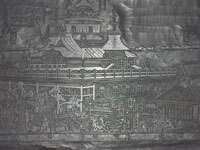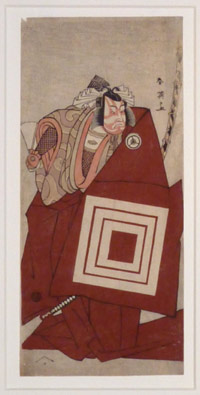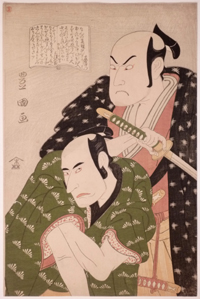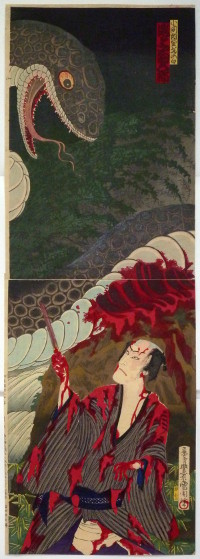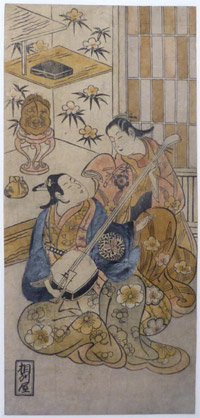/category/actors/page/5/
Ichiyosai YOSHITAKI (1841-1899. Active c1854-1885)
Click here to view image full size.
A large head oban print of the actor Nakamura Kanjaku II as Takeda Katsuyori (?) from a rare set: Zen (?) kurabe nishiki utsushie, ‘A Comparison of Virtuous Pictures.’ Published c1859. This is the first deluxe edition with extensive burnishing, gold and silver. The set was reissued without these embellishments.
Very fine impression and colour. Some soil, offsetting and slight trimming. Signed Yoshitaki hitsu.
Status: Sold
Kinoshita HIRONOBU I (Active c1851-1870)
Click here to view image full size.
A large head oban print of the actor Otani Tomomatsu I as Yaegaki hime from a rare set: Zen (?) kurabe nishiki utsushie, ‘A Comparison of Virtuous Pictures.’ Published c1859. This is the first deluxe edition with extensive burnishing, gold and silver. The set was reissued without these embellishments.
Very fine impression and colour. Some soil, offsetting and slight trimming. Signed Hironobu ga.
Status: Sold
Kinoshita HIRONOBU I (Active c1851-1870)
Click here to view image full size.
A large head oban print of the actor Arashi Tokusaburo II ( or III [?] ) as Hangari on’na from a rare set: Zen (?) kurabe nishiki utsushie, “A Comparison of Virtuous Pictures.” Published c1859. This is the first deluxe edition with extensive burnishing, gold and silver. The set was reissued without these embellishments.
Very fine impression and colour. Some soil, offsetting and slight trimming. Signed Hironobu ga.
Status: Sold
Ichiyosai YOSHITAKI (1841-1899. Active c1854-1885)
Click here to view image full size.
A large head oban print of the actor Sancho Daisho (?) as the pirate Watonai ( Kokusenya, Coxinga ) from a rare set: Zen (?) kurabe nishiki utsushie, ‘A Comparison of Virtuous Pictures.’ Published c1859. This is the first deluxe edition with extensive burnishing, gold and silver. The set was reissued without these embellishments.
Very fine impression and colour. Some soil, offsetting and slight trimming. Signed Yoshitaki hitsu.
Status: Sold
Kochoro KUNISADA (1786-1865)
Click here to view image full size.
An original wood block showing actors as Kuzunoha and Abe no Yasuna. Kuzunoha was the fox wife of Yasuna and is usually depicted nursing her child or appearing as a white fox giving Yasuna the key to her disappearance in a dream. Au verso is an uninteresting design by Yoshifuji entitled Toita zukushi, a “Collection of Sliding Doors.” Rare: Blocks of seasoned wood had become expensive in the 19th century and old blocks were often planed down to be reused by later artists/publishers. Important blocks seldom come onto the market, and the few that do are invariably for later copies. Most were reused and/or burnt and destroyed. Signed Toyokuni ga. Publisher’s seal not read. Censors’ seals for 1849 – 53. Sold as is with some slight edge wormage, but otherwise surprisingly good condition.
Status: Sold
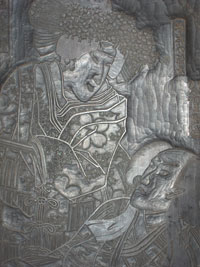
Click here to view image full size.
Utagawa TOYOKUNI (1769-1825)
Click here to view image full size.
A silver mica-ground double bust portrait of Hikosaburo Bando III as Kan Shojo ( Sugawara Michizane ) disgraced and sent to Tsukushi, and Kataoka Nizaemon VII as Hakudayu from the play Sugawara denju tenarai kagami, “Sugawara’s Secrets of Calligraphy.” The play was written for the puppet theatre in 1746 and quickly adapted for Kabuki. Published by Yamaden, Kansei 8 ( 1796 ). Extremely rare. Unidentified collector’s seal au verso.
Fine impression. Perfect colour. Some slight loss of mica ( as per usual ) and a slight centre fold. Signed Toyokuni ga.
Status: Sold
Kochoro KUNISADA (1786-1865)
Click here to view image full size.
An extremely important original wood block. Shows the onnagata actor Onoe Kikugoro IV as the chinohito, ‘wet-nurse,’ Masaoka, in the play ‘Konoshita Masagono Date-zome,’ performed at the Ichimura Theatre, 9/1855. Designed for the late, fine set of deluxe bust portaits published by Ebisuya Shoshichi ( except two ) between 1860 and 1869. There are also eleven designd by Yoshitora. The culmination of Kunisada’s carrer. On the reverse of the block is a design by Utagawa Kunitoshi ( 1847 – 99 ) with title Tokyo meisho Kaiunbashi dai-ichi kokuritsu ginko, ‘First National Bank at Kaiun Bridge, Famous Views of Tokyo.’ Published Meiji 10 ( 1877 ) by Naraha Shutei. Signed Kunitoshi hitsu. Blocks of seasoned wood had become expensive in the 19th century and old blocks were often planed down to be reused by later artists/publishers. Important blocks seldom come onto the market, and the few that do are invariably for later copies. Most were reused and/or burnt and destroyed. Signature Toyokuni ga with publisher’s seal Kinshodo and Sho; carver’s seal choko Ryuzo and Aratame censor’s seal 3/1860. Sold as is with some slight edge wormage, but otherwise surprisingly good condition.
Status: Sold
Kochoro KUNISADA (1786-1865)
Click here to view image full size.
A fine view of the inside of a theatre with a performance taking place. The faces of the audience in the stalls are carefully drawn and it’s obvious that many were meant to be recognised. Published by Noshuya Yasubei, 1858. Rare.
Fine impression and colour. Offsetting on last sheet and trimmed slightly on left. Other minor marks and rubbing. Signed Ichiyosai Hinajishi Toyokuni ga.
Status: Sold
Toyohara KUNICHIKA (1835-1900)
Click here to view image full size.
A vertical diptych showing Onoe Kikugoro V as Nikki Danjo transforming himself by majic into a rat. In his mouth the stolen will with which he was trying to strip Tsuru-chiyo of his inheritance. Title of play: Meibuku Sendai hagi, “The Disputed Succession.” Published by Fukuda Kumajiro, 1887. Rare.
Fine impression. Very good colour. Some burnishing. Slight offsetting and oxidation. Retains original album backing. Signed Toyohara Kunichika hitsu.
Status: Sold
Toyohara KUNICHIKA (1835-1900)
Click here to view image full size.
A vertical diptych depicting the story of the Inaba Apprentice. Title: Inaba ama-yobanashi. Shows Onoe Kikugoro V as the ghost of Saijiro; Bando Kakitsu as Kanbara Mikinosuke and Onoe Matsukuke as Nakama Gonbee. Published by Fukuda Kumajiro, 1887. Extremely rare.
Fine impression and colour. Hand-applied pigment to the head of the ghost. Some silver and burnishing. Retains original album backing. Signed Oju Toyohara Kunichika hitsu.
Status: Sold
Toyohara KUNICHIKA (1835-1900)
Click here to view image full size.
A vertical diptych showing the actor Onoe Kikugoro V, dagger in hand and covered in blood, confronting a giant serpent. Published by Fukuda Kumajiro, 1887. Extremely rare.
Fine impression and colour. Extensive mica applied to the serpent. Retains original album backing. Signed Oju Toyohara Kunichika hitsu.
Status: Sold
Toyohara KUNICHIKA (1835-1900)
Click here to view image full size.
A vertical diptych showing the actors Ichikawa Danjuro as the teacher Kondo Tatsuo and Ichikawa Sadanji as Mikura Tomizo. Title: Kishu no oki kisen chinbotsu no ba, “ Sunken Ship in the Sea off Kishu Province.” Published by Fukuda Kumajiro, Meiji 20, 11th month ( 1887 ).
Fine impression and colour. Extensive mica and gofun applied. Retains original album backing. Signed Oju Toyohara Kunichika hitsu.
Status: Sold
Utagawa TOYOKUNI (1769-1825)
Click here to view image full size.
An aiban bust portrait showing Iwai Hanshiro IV in an onnagata role. Published by Yamaguchi Chusuke c 1794. Another aiban okubi-e of the same actor in another onnagata role and of the same date was published by Tsuruya Kiemon. A rare and fine design.
Fine impression. Very good colour. Slight trimming, otherwise very good condition. Signed Toyokuni ga.
Status: Sold
Ichiyusai KUNIYOSHI (1797-1861)
Click here to view image full size.
The complete set of five prints: Date otoku kisho kurabe, “A contest of Fashionable Men.” Shows actors as otokodate ( so-called chivalrous commoners, recognisable by the fact that they carried a sword together with a shakuhachi [ bamboo flute ] showing proficiency in the martial arts and music ). Published c 1847-1850 by Iseya Ichibei.
Fine impressions. Fine colour. Slight trimming and backed binding holes, otherwise good condition. Signed Ichiyusai Kuniyoshi ga.
Status: Sold
Katsukawa SHUNKO (1743-1812)
Click here to view image full size.
Ichikawa Yaozo III in a Shibaraku role c 1800. This standard Kabuki interlude was invented by Danjuro I as part of the drama Sankai Nagoya in 1697 and translates as “Wait a moment.” The long brick-red costume with the immense mon produced some of the most striking images in ukiyo-e. The best of Shunko’s work certainly equals that of his master and teacher, Shunsho. Provenance: Ex collection Dr. and Mrs. James B. Austin, illustrated in Eight Hundred Years Of Japanese Printmaking, Museum of Art, Carnegie Institute, Pittsburgh, 1976/77, illustration 326, p.79.
Good impression and colour. Slight centre fold and minor marks, otherwise very good condition. Signed Shunko ga.
Status: Sold
Ichiryusai HIROSHIGE (1797-1858)
Click here to view image full size.
An excessively rare triptych showing the interior of a large mansion where a private performance of Kabuki interlude plays is being performed. Some of the most famous actors of the day are shown: Bando Mitsugoro III, Iwai Hanshiro V, and Ichikawa Danjuro VII. One of Hiroshige’s earliest prints published c 1818-20 when Hiroshige was 22-24 years old. Two other impressions appear to be known: The Tamba impression illustrated in The Art of Hiroshige, Tsuneo Tamba, 1965, no.122, p.58; and the Suzuki copy illustrated in Utagawa Hiroshige, Juzo Suzuki, 1970, no.86, which is the impression shown in the Memorial Exhibition of Hiroshige, Number Eighteen, Ukiyo-e Art, The Japan Ukiyo-e Society, 1968, no.1.
Good impression and colour. Some small areas of expert restoration, otherwise good condition. Signed “By special request” Hiroshige ga.
Status: Sold
Utagawa KUNISADA (1786-1865)
Click here to view image full size.
Shiragikumaru from the play Tsuruya Namboku riding the back of an enormous
prehistoric-looking sea animal. From the set: Toyokuni kigo kijutsu kurabe, “A Contest of Magic-scenes by Toyokuni” published by Hiranoya Shinzo 12/1864. One of the best designs from the set.
Superb deluxe impression with burnishing, mica, splashed gofun and best-quality pigments. Perfect colour. Very slight trimming, otherwise fine. On deluxe hosho. Signed Shichijuku-sai Toyokuni hitsu, “The seventy-nine year old Toyokuni drew.”
Status: Sold
Torii KIYOMASU I (Active c1700-1722)
Click here to view image full size.
The actor Nakamura Takesaburo playing a female itinerant tea vendor. A pair of panniers is slung across his shoulders holding the paraphernalia for tea making including, in the lower sections, a brazier and water jug. Published c1716-20 by Sagamiya. Published in Yamaguchi and Asano ( 1982 ), Moronobu – Harunobu, vol.6 of the Complete Dictionary of Ukiyo-e, Tokyo, Shogakukan, pl.86, p.46. Probably the only known impression extant.
Very good impression with fine contemporary hand-colouring. Expertly restored corners and areas at left and bottom edges. One repaired wormhole beside the hand holding the bamboo rod. Signed Torii Kiyomasu hitsu.
Status: Sold
Ichieisai YOSHITSUYA (1822-1866)
Click here to view image full size.
A print from a set of three with title: Sanshibai mitate tako, “Parody of the Three Plays Shown as Kites”. Shows various kite designs together with accoutrements to kite flying. The actors image/s together with other clues gave the name of the play which would have been obvious to the public at the time. Published 1862. Unidentified publisher. The only time I have recorded this print.
Good impression and colour. Some soil and small restorations, otherwise good condition. Signed Ichieisai Yoshitsuya ga.
Status: Sold
Ichieisai YOSHITSUYA (1822-1866)
Click here to view image full size.
A print from a set of three with title: Sanshibai mitate tako, “Parody of the Three Plays Shown as Kites”. Shows various kite designs together with accoutrements to kite flying. The actors image/s together with other clues gave the name of the play which would have been obvious to the public at the time. Published 1862. Unidentified publisher. The only time I have recorded this print.
Good impression and colour. Some soil and small restorations, otherwise good condition. Signed Ichieisai Yoshitsuya ga.
Status: Sold
Katsukawa SHUN’EI (1762-1819)
Click here to view image full size.
The actor Segawa Kikunojo III as Yasukata performing a vigorous hobby-horse dance in Godai Genji mitsugi no furisode. Published by Tsuruya Kiemon c1790-91. Ex Tamba collection (seal bottom right).
Very good impression, colour and condition. Signed Shun’ei ga.
Status: Sold
Taiso YOSHITOSHI (1839-1892)
Click here to view image full size.
An actor as a tattooed fireman from a set of seven prints Isami no Kotobuki. “A Celebration of Gallantry”. Firemen often had elaborate tattoos to show their indifference to pain. The set published by Daikin 8/1865. Rare.
Very fine impression and colour. On thick deluxe hosho. Extensive burnishing. Gofun oxidised (as usual). Slight offsetting of blue pigment, otherwise very good condtion. Signed Gyokuo Yoshitoshi hitsu.
Status: Sold
Taiso YOSHITOSHI (1839-1892)
Click here to view image full size.
An actor as a tattooed fireman from a set of seven prints Isami no Kotobuki. “A Celebration of Gallantry”. Firemen often had elaborate tattoos to show their indifference to pain. The set published by Daikin 8/1865. Rare.
Very fine impression and colour. On thick deluxe hosho. Gofun oxidised (as usual). otherwise fine condtion. Signed Gyokuo Yoshitoshi hitsu.
Status: Sold
Utagawa KUNISADA (1786-1864)
Click here to view image full size.
A lively design showing Ichikawa Danjuro VII in the role of the loyal warrior Arajishi Otokonosuke Terumitsu fighting a giant rat in the cellar beneath the women’s quarters of the Ashikaga Palace. This scene, Yukashita no Ba, is from the play Date kurabe okuni Kabuki performed at the Kawarasaki-za Theatre, 3/1829. Shortly afterwards, the rat escapes down a hole in the hanamichi pathway, only to re-emerge in a cloud of smoke as the arch-villain and master of the black arts, Nikki Danjo. Published by Eikyudo (Yamamoto Kyubei) 1829.
Fine impression, colour and condition on an extra large sheet of hosho. Signed Gototei Kunisada ga.
Status: Sold
Utagawa KUNISADA (1786-1864)
Click here to view image full size.
A fine surimono showing the actor Danjuro VII casting roasted beans from a tray he holds in his left hand. This ritual called setsubun, “end of winter” was performed in the precincts of temples in the Spring (although now takes place in February). He wears the well known Shibaraku costume with the large mimasu crests. Two poems above by Shiseido Sutena and Hoichitei Masunari. The latter being a member of the Taiko-ren, Drum poetry club. Their symbol top right corner. Issued c 1822. Illustrated in colour on the front cover of Art of the Surimono, Theodore Bowie, Indiana University Art Museum, 1979. Rare.
Superb impression with extensive gold and silver. Perfect colour. Light Japanese backing and slightly trimmed at left. Signed Gototei Kunisada ga.
Status: Sold
SESSHUNSAI (Dates unknown but active c 1800)
Click here to view image full size.
An extremely rare early Osaka hosoban showing the actor Asao Tamejuro II (1779-1806) standing before a broken barricade in the role of Yamashiro Kantsubo in the play Meiboku sendai hagi. This artist and print appear to be unrecorded. Published by Houki (Honya Kichisai), c early 1800. A wonderful design. Many thanks to Hendrick Luhl for his help on this print.
Very good impression and colour. The fujitive background aobana, dayflower pigment, intact except for one small area affected by moisture visible au verso. Very good condition. Signed Sesshunsai ga with seal unread.
Status: Sold
Jokei RYUKOSAI (Fl. c 1772-1816)
Click here to view image full size.
The most important and influential Osaka artist of the late eighteenth century. An innovator whose style may well have influenced such artists as Shunei and Sharaku. His prints – mostly hosoban – are all of the utmost rarity. Indeed, it is thought they originally formed triptychs but, so far, no complete design has been located. The oban design offered here is even rarer, there being only two other impressions known: Illustrated in colour, pl. 13, in Kamigata Ukiyo-e Nihyaku-nen Ten, “200 Years of Kamigata Ukiyo-e,” Susumu Matsudaira, 1975; and pl. 43, p. 56, catalogue of exhibition Ukiyo-e of the Kamigata Area at the Osaka Museum of History and Yamaguchi Prefectural Hagi Uragami Museum, Kitagawa Hiroko, 2014. Shows five actors. From right to left (rear): Nakamura Kyojuro, Arashi Sangoro III, Kataoka Nizaemon VII and (front): Asao Tamejiro I, Ichikawa Danzo IV. Published c 1790 by Ki.
Fine impression. Very good colour. Small areas of contemporary hand colouring to face and costume of Tamejiro. Slight folds and small sumi mark bottom left, otherwise very good condition. Probably full size. Signed Ryukosai ga.
Status: Sold
Jokei RYUKOSAI (Fl. c 1772-1816)
Click here to view image full size.
The most important and influential Osaka artist of the late eighteenth century. An innovator whose style may well have influenced such artists as Shunei and Sharaku. His prints – mostly hosoban – are all of the utmost rarity. Indeed, it is thought, as here, that they originally formed triptychs but, so far, no complete design has been located. The unsigned left panel of a triptych published 1/1793 showing Onoe Shinshichi I (Fujaku) as Isshiki Yukinokami in the play Keisai yanagi sakura. The play involves the rescue of the Ashikaga Shogunate through the efforts of Yukinokami in uncovering a usurper’s plot. The hero stands in a snowy garden holding a fragment of a handscroll he has been found reading. Of the utmost rarity: Only a few impressions are known and there are two states: As here without role above and published by Osakaya Sashichi and with the calligraphy and published by Shiocho.
Fine impression, colour and condition.
Status: Sold
TOGAKUSAI (Active c 1782)
Click here to view image full size.
An extremely rare and early Osaka hosoban (probably unrecorded) showing the actor Kano Hinasuke I (who later became Arashi Koroku III) standing on large geta and holding an umbrella. Published by Shioki-han (Shioya Kisuke), c 1782. The poem above is signed using the actor’s hango Arashi Minshi. Only a few designs are known by this artist. Many thanks to Hendrick Luhl for his help on this print.
Very good impression and colour. Some wear and tear which has been skilfully restored. On very thin paper. Signed Togakusai hitsu with seal Sadakuni.
Status: Sold
Utagawa KUNISADA (1786-1864)
Click here to view image full size.
An exceptionally rare original double-sided woodblock. On one side is the key-block showing Ichikawa Danjuro VII as the strongman, “chikaramochi,” Ura no Kingo. On the other is the key-block showing Iwai Kumesaburo II as the female acrobat, “karuwazashi,” Tamamoto Kosan. The play is Fujikawabune noriai banashi performed at the Nakamura-za Theatre, 5/1826. The block measures 8.5 x 10.75 x .75 in; 21.6 x 27.3 x 2 cms. The two images signed Gototei Kunisada ga. In very good condition but with obvious minor damage. Sold “as is.”
Status: Sold

Click here to view image full size.
Taiso YOSHITOSHI (1839-1892)
Click here to view image full size.
An actor as a tattooed fireman from a set of seven prints Isami no Kotobuki. “A Celebration of Gallantry”. Firemen often had elaborate tattoos to show their indifference to pain. The set published by Daikin 8/1865. Rare.
Very fine impression and colour. On thick deluxe hosho. Gofun oxidised (as usual). otherwise fine condtion. Signed Gyokuo Yoshitoshi hitsu.
Status: Sold
Katsukawa SHUNSHO (1726-1792)
Click here to view image full size.
The actors Ichimura Uzaemon IX and Bando Matatoro IV (hand-written in sumi) grappling together. Published c.1768. Not in Gookin.
Very good impression. Some fading. Wonderful blue ground. Very good condition. Signed Shunsho ga with Hayashi in jar-shaped outline seal.
Status: Sold
Katsukawa SHUNEI (1762-1819)
Click here to view image full size.
Iwai Hanshiro IV in a shibaraku role, probably as Akita Jonosuke Yoshikage from the play Mieiko nori no hachi no ki performed at the Kawarazaki Theatre in the 11th month, 1791. Published by Harimaya Shinshichi. Ex Beres collection, sold Paris 2002, lot 39.
Fine impression; very good colour. Slight edge thinning and very small nick out of top margin, otherwise very good condition. Signed Shunei ga.
Status: Sold
Utagawa TOYOKUNI I (1769-1825)
Click here to view image full size.
The actors Otani Tomoemon II as Iwaki Yagenji and Bando Mitsugoro II as Wakato Tomoji in the play Tsuki wa Musashino aki no sewa goto performed at the Kiriza theatre, 7/1797. One of Toyokuni’s best double bust portraits. Published by Moriya Jihei 1797. Ex Hayashi collection ( seal top left ).
Fine impression. Very good colour. Very slight centre fold and one small wormhole. Signed Toyokuni ga.
Status: Sold
Katsukawa SHUNSHO (1726-1792)
Click here to view image full size.
The actor Ichikawa Danjuro V as Kajiwara Genta. Published c early 1780s. Illustrated in T.N.M.C. vol.1, no. 1051. A night scene. The actor deploys an umbrella and holds a lantern with the other hand. Not listed by Gookin.
Very good impression and colour. Some oxidation. Signed Shunsho ga.
Status: Sold
Toyohara KUNICHIKA ( 1835-1900 )
Click here to view image full size.
A vertical diptych showing the actor Onoe Kikugoro V in the role of Komamonoya Saijiro, “Saijiro of the haberdashery store,” fighting a giant serpent in the play Inaba Kozo ame no yobanashi performed at the Nakamura-za theatre in 11/1887. Published by Fukuda Kumajiro in 1887. Evidently the actor was swallowed whole during this scene ! An extremely rare print.
Fine impression and colour. Extensive mica on the serpent’s head and body. This is the only impression of this design I have seen retaining the publication details in the left margin ( albeit even here slightly trimmed ). Very good condition. Ample margin for joining the two sheets. Signed Oju Toyohara Kunichika hitsu.
Status: Sold
Utagawa KUNISADA ( 1786-1864 )
Click here to view image full size.
An uncut fan print showing a bust portrait of the actor Nakamura Shikan II as Matsuomaru in the scene Kuruma-biki from the play Sugawara denju tenari kagami, “Sugawara’s Secrets of Calligraphy” performed at the Nakamura-za theatre, 5/1832. This episode gives rise to one of Kabuki’s most celebrated scenes involving Matsuomaru’s two brothers and the carriage of Shihei. Extremely rare. Published 1832. Publisher not identified.
Very good impression and colour. Slight vertical crease and small edge wormage at top, otherwise good condition. Signed Gototei Kunisada ga.
Status: Sold
Utagawa KUNISADA ( 1786-1864 )
Click here to view image full size.
The actor Nakamura Shikan II as Shoki, the demon queller. One of the nine roles in the hengemono dance Kyo kokonoe yayoi no hanamichi performed at the Nakamura-za theatre, 3/1833.Shoki ( Chin: Chung K’uei ) is said to have visited the sick T’ang dynasty emperor, Ming Huang, when he was tormented by fever demons. He recovered and Shoki told the emperor he had promised to rid the country of evil to repay the respect given him by a past emperor after he committed suicide. A favourite character in Japan, he is often depicted in red to ward off evil spirits and shown fighting demons. Paintings of Shoki were hung on Boy’s Day. Published by Yamamoto Kyubei, 1833. Rare.
Very good impression and colour. Slight soil and edge crease at left edge, otherwise good condition. Signed Gototei Kunisada ga.
Status: Sold
Okumura TOSHINOBU (active c. 1717-1750)
Click here to view image full size.
A hosoban showing an interior scene with the actor Ogino Isaburo I ( 1703-48 ), seated and playing a shamisen with a plectrum. Behind him is a courtesan, one hand on the shamisen. Toshinobu may have been the adopted son of Okumura Masanobu. Published by Soshu ( Sagami ) – ya c. 1725-30.
Good impression. Nice hand colouring with beni, mustard, yellow, blue and the addition of gum and gold powder ( bronze or brass ). Slight toning and loss of gold. Unsigned.
Status: Sold
Utagawa KUNISADA (1786-1864)
Click here to view image full size.
A bust portrait of the famous quick-change actor Bando Mitsugoro III as Kajiwara Genta Kagetoki. Performed at the Ichimura-za Theatre in the 3rd month 1811 ( Bunka 8 ). From Kunisada’s finest set: Oatari kyoden no uchi, “Great Performances.” A set of seven prints of celebrated roles of the previous eight years selected from the Oatari kyogen, “Big Hits.” Sumptuously produced with mica grounds which had not been used for twenty years. The expressive poses hark back to similar prints by Toyokuni I and Kunimasa. Exceedingly rare, on a par with many Sharaku prints. Published by Fukusendo, c 1815. Another impression is in the Rietberg Museum, Zurich.
Fine impression. Slightly trimmed left side towards the top and repaired binding holes at top, otherwise good condition. Very good colour with the mica well retained. Signed Gototei Kunisada ga.
Status: Sold









